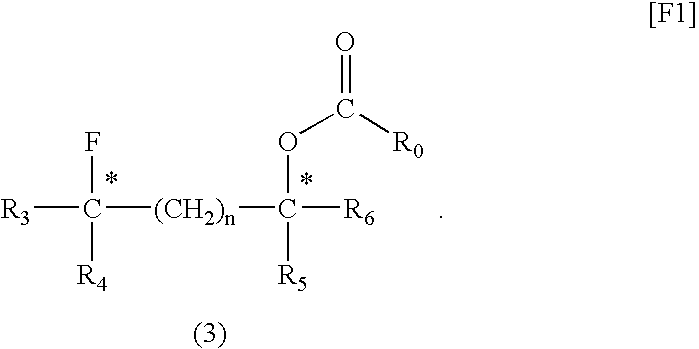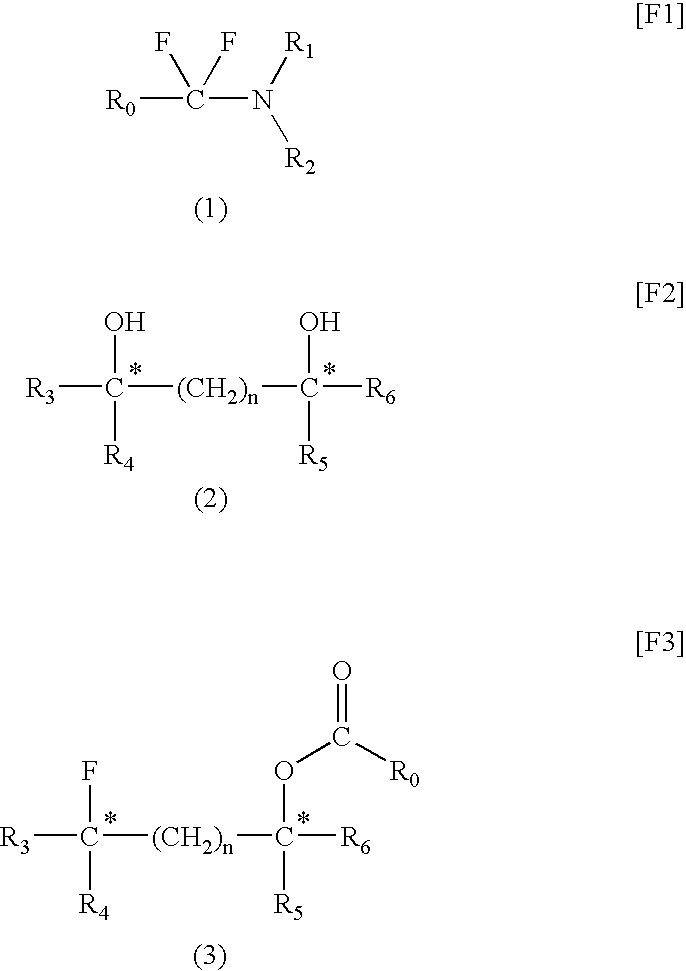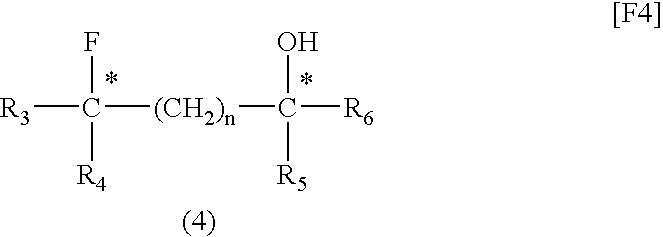Process for producing optically active fluorochemical
a technology of fluorochemical and optically active compounds, which is applied in the preparation of oxygen-containing compounds, organic chemistry, chemistry apparatuses and processes, etc., can solve the problems of difficult to achieve selective production of a desired optical isomer, difficult to obtain high-quality optical purity final product, and difficult to selectively fluorinate only one hydroxyl group of diol, etc., to achieve the effect of easy production
- Summary
- Abstract
- Description
- Claims
- Application Information
AI Technical Summary
Benefits of technology
Problems solved by technology
Method used
Image
Examples
referential example 1
(Synthesis of N,N-diethyl-α,α-difluoro-(3-methyl)benzylamine)
a) Synthesis of N,N-diethyl-α-chloro-m-toluylamidium chloride
[0043]Under nitrogen, a carbon tetrachloride solution (125 g) containing oxalyl chloride (25 g, 0.197 mol) was fed into a three-neck flask (300 mL). While the flask was cooled with ice, N,N-dimethyl-m-toluamide (45 g, 0.236 mol) was added dropwise to the above solution over 20 minutes under stirring. After completion of addition, the mixture was maintained at the same temperature for 10 minutes. The content of the flask was heated to 50° C. and allowed to react for one hour. During reaction, gas generation was observed and, thereafter, a white solid was precipitated. The precipitate was collected through filtration and washed with carbon tetrachloride and n-hexane, followed by drying, to thereby produce 47.5 g of N,N-diethyl-α-chloromethyltoluylamidium chloride (yield: 98%).
b) Synthesis of N,N-diethyl-α,α-difluoro-(3-methyl)benzylamine
[0044]To a three-neck flask ...
referential example 2
(Synthesis of N,N-diethyl-α,α-difluoro(2-methoxy)benzylamine)
a) Synthesis of 2-methoxy-N,N-diethylbenzamide
[0045]A solution of diethylamine (25.8 g, 0.352 mol) in toluene (toluene 30.8 g) was placed in a 200-mL four-neck flask. Under cooling with ice, a solution of 2-methoxybenzoic chloride (20 g, 0.117 mol) in toluene (toluene 10.0 g) was added dropwise gradually in order to prevent sudden surge of heat. After completion of addition of the entire amount of the solution, the formed amine hydrochloride was removed through extraction with water. The thus-obtained toluene layer was dried over MgSO4, and the solvent was vaporized out, to thereby yield 22.8 g of 2-methoxy-N,N-diethylbenzamide (yield: 94%).
b) Synthesis of N,N-diethyl-α-chloro(2-methoxy)phenylamidium chloride
[0046]A 200-mL four neck flask was purged with nitrogen, and a 45% solution of oxalyl chloride (oxalyl chloride: 24.5 g, 0.193 mol) in carbon tetrachloride was added to the flask. Under nitrogen, the above-synthesized ...
example 1
Fluorination of (2S,4S)-pentane-2,4-diol
[0052](2S,4S)-Pentane-2,4-diol (1 mmol), dioxane (1 mL), and fluorinating agent A (1 mmol) were placed in a Teflon (registered trademark) PFA container and sufficiently mixed. The mixture was placed in a microwave irradiator (product of Sharp, 2.45 GHz, 500 W) and irradiated with a microwave for 10 minutes. After cooling, fluorinating agent A (1 mmol) was further added to the mixture, and the resultant mixture was irradiated with a microwave for another 10 minutes. The reaction mixture was cooled to room temperature, and poured into a saturated aqueous sodium hydrogencarbonate solution. The system was subjected to extraction with ether (40 mL, three times). The ether solution was dried over magnesium sulfate, concentrated, and purified through silica gel column chromatography, whereby (2S,4R)-2-(3-methylbenzoyloxy)-4-fluoropentane, which is a target compound, was produced (yield: 78%, optical purity: 100%).
PUM
| Property | Measurement | Unit |
|---|---|---|
| temperature | aaaaa | aaaaa |
| frequency | aaaaa | aaaaa |
| frequency | aaaaa | aaaaa |
Abstract
Description
Claims
Application Information
 Login to View More
Login to View More - R&D
- Intellectual Property
- Life Sciences
- Materials
- Tech Scout
- Unparalleled Data Quality
- Higher Quality Content
- 60% Fewer Hallucinations
Browse by: Latest US Patents, China's latest patents, Technical Efficacy Thesaurus, Application Domain, Technology Topic, Popular Technical Reports.
© 2025 PatSnap. All rights reserved.Legal|Privacy policy|Modern Slavery Act Transparency Statement|Sitemap|About US| Contact US: help@patsnap.com



